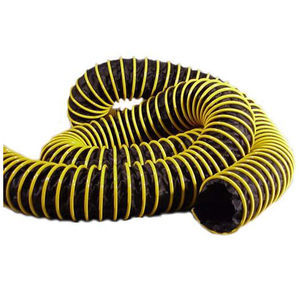
- Company
- Products
- Catalogs
- News & Trends
- Exhibitions
Exhaust gas hose EF2compositefabricsynthetic
Add to favorites
Compare this product
Characteristics
- Use
- for exhaust gas
- Material
- synthetic, fabric, composite
- Applications
- heavy-duty
- Other characteristics
- abrasion-resistant, flame-retardant, high-resistance
- Inner diameter
100 mm, 125 mm, 150 mm, 200 mm
(3.937 in, 4.921 in, 5.906 in, 7.874 in)- Temperature
300 °C, 350 °C
(572 °F, 662 °F)- Delivered length
5 m, 10 m, 12.5 m
(16'04" , 32'09" , 41'00" )
Description
• The EF2 hose is made up of a synthetic composite fabric that can endure exhaust gas temperatures of up to 300°C (570°F) continuous. -Available only in North America-
Features
• High resistance to mechanical loadings
• Flame retardant
• Abrasion resistant
The synthetic composite fabric hose (EF2) is used with Plymovent vehicle exhaust systems.
The EF2 is designed to extract hazardous fumes generated by gasoline and diesel engines. It is made up of a specialty coated high temperature synthetic woven fabric that is designed to handle flammable dust and particles, and can endure exhaust gas temperatures of up to 300°C (570°F) continuous. Intermittently, the EF2 hose can endure 350°C (660°F) provided there is approximately 50% of fresh air supplied. The external helix is made up of galvanized steel with additional plastic abrasion.
Recommended for
• Heavy-duty vehicle workshops
• Public works service garages
• Mass transit service facilities
• Fleet maintenance facilities
• Vocational technical schools
Features
• Abrasion resistant
• Extremely flexible
• Super lightweight
• Vibration resistant
• Highly flexible and compressible
• High resistance to mechanical loadings
• Flame retardant (designed to handle flammable dust and particles)
Catalogs
No catalogs are available for this product.
See all of PLYMOVENT‘s catalogsRelated Searches
- PLYMOVENT piping
- Structure hose
- PLYMOVENT flexible hose
- Elastomer hose
- Abrasion-resistant hose
- Fixed reel
- Hose reel
- Spring rewind reel
- Steel hose
- Air flexible piping
- Standard hose
- Lightweight flexible piping
- Gas hose
- High-temperature flexible piping
- Manual reel
- Synthetic hose
- Motorized reel
- Mobile reel
- Fabric hose
- Hose for automotive applications
*Prices are pre-tax. They exclude delivery charges and customs duties and do not include additional charges for installation or activation options. Prices are indicative only and may vary by country, with changes to the cost of raw materials and exchange rates.








